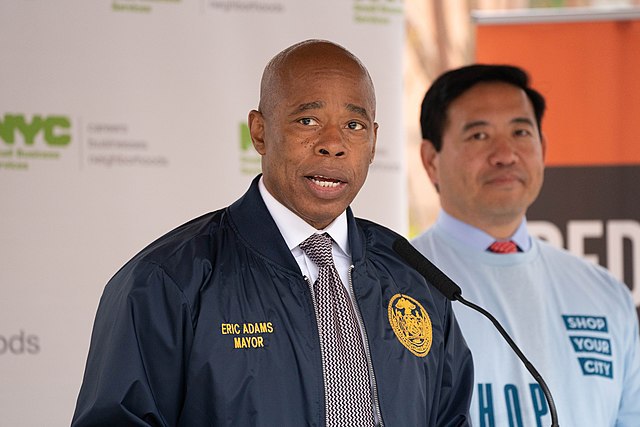Over 120,000 asylum seekers have flocked into New York City since the spring of 2022, requiring billions of dollars in additional city spending to shelter and care for migrants. As city agencies are forced to slash their budgets to mitigate the crisis, residents and politicians alike are debating the most effective way to preserve the city financially — while still remaining true to its humanitarian values — and whether a suspension to the city’s “right-to-shelter” law is a step in the right direction.
Migrants have been coming to the city in large numbers seeking refuge from political upheaval or economic hardship in their home countries, vastly arriving from either Latin America or West Africa. As a result, the city has been opening an increasing number of shelters across a variety of locations, including hotels, office buildings, and school gymnasiums.
Isaac Adlerstein, executive director of the homeless and poverty services organization Broadway Community, noticed this shift firsthand in recent months. “We have seen a dramatic increase in the number of migrants who have come to our soup kitchen and to our food pantry,” Adlerstein said. “As for our shelter, we’ve seen an uptick, naturally, because people come to our soup kitchen and food pantry and many folks request shelter from there.”
In addition to his role as executive director of Broadway Community, Alderstein has also gained direct exposure to New York City’s migrants through his role as interim director of New York City Mayor Eric Adams’ recently launched faith-based shelter program, announced in June 2023, with the goal of opening 50 shelters within houses of worship across the five boroughs. Alderstein remarked, “We can debate the politics all we want, but the fact is that people are here in the city. And while they’re here in the city, they do need a place to stay and eat.”
However, the debate about the influx of asylum seekers in New York City remains politically charged.
About 10% of the city’s newest migrants were bused into the city throughout this year by Governor Greg Abbott of Texas, who asserted that the handling of migration in the city is “calm and organized” compared to his own situation in Texas.
The White House has also notably ignored Mayor Adams’ pleas for federal assistance, leaving the city to handle the crisis vastly on its own. Adlerstein pointed out, “The places that are being most acutely affected by the migrant crisis are places that are safely Democrat, so I think part of the President’s logic and part of the governor’s logic is, ‘New York City will vote for us no matter what.’”
Even on a local level, many residents are becoming increasingly wary of incoming migrants. Alderstein explained, “I think there’s been very poor communication between local elected officials and local communities before they put shelters in particular areas. That just leads to increased tensions and temperatures rising in general.” He cited an instance of such tensions that culminated in September, when migrants were ordered by a Staten Island judge to vacate a shelter in St. John’s Villa Academy due to fervent protesting from local residents.
With little external financial support and increased pressure from residents to resolve the crisis, Mayor Adams has announced plans to implement significant budget cuts to care for and house asylum seekers, starting with 5% cuts to all city agencies by November, potentially increasing to 15% by the spring. Adams warned that while the cuts are necessary to mitigate the current crisis, they would eventually send New York into a “financial tsunami” and “hurt low-income New Yorkers.”
Alderstein pointed out that despite Adams’ proposed budget cuts, “We’re having the largest budget of all time in the city, $107 billion for Fiscal Year 2024. But at the same time, there are going to be budget cuts of up to 5%, which kind of just brings us back to the baseline of beforehand. So I think some of that is political opportunism.”
Urban Studies Professor Eric Goldfischer added, “In reality, a 5% budget cut is going to impact some agencies very differently than other agencies. A 5% cut to the police is not going to impact them in the same way that it’s going to impact a school agency. I think an equitable response to the situation would actually be to find a way to beef up the funding for agencies that are going to be doing the work around helping folks get settled here, and then probably look for budget cuts elsewhere, from agencies that are not underfunded.”
To resolve the crisis, Mayor Adams has moved to temporarily suspend New York’s right-to-shelter law; this law being one that requires New York City to provide shelter to anyone who asks for it since its decree in 1981. His decision generated major controversy among homeless services organizations, with several issuing statements asserting that the suspension would lead to a massive increase in street homelessness across the city.
Professor Goldfischer weighed in on the issue, saying, “I think generally, where I’m at right now is that we can reduce a lot of barriers to housing, while still having the right to shelter for now. But long term, I’m not convinced it’s the right thing.” He cited a 2023 study that found that permanently housing asylum seekers rather than just sheltering them could save the city over $3 billion annually, noting that the average single adult stays in New York City shelters for over 16 months, which is ultimately a “Band-Aid solution.”
Alderstein echoed Goldfischer’s sentiment, stating that, “The concept that if all the migrants are granted the ability to work they will somehow leave the shelter system — that’s pretty much a fantasy, I’m sorry to say. There are over 6,000 vacant apartments in NYCHA, New York City Housing Authority, in New York City’s own public housing. I think we can definitely address the housing crisis as well; it goes hand in hand with the migrant crisis.”
Goldfischer suggested additional policy changes to streamline the process of asylum seekers integrating into New York City society, saying, “The federal government requires everything on paper, and it’s insane. They’re acting like it’s 1995. So digitize everything, and also just get rid of waiting periods generally. If people can get their applications processed faster on a computer, not on a snail mail and a fax machine, those sorts of things would make a big difference.”











